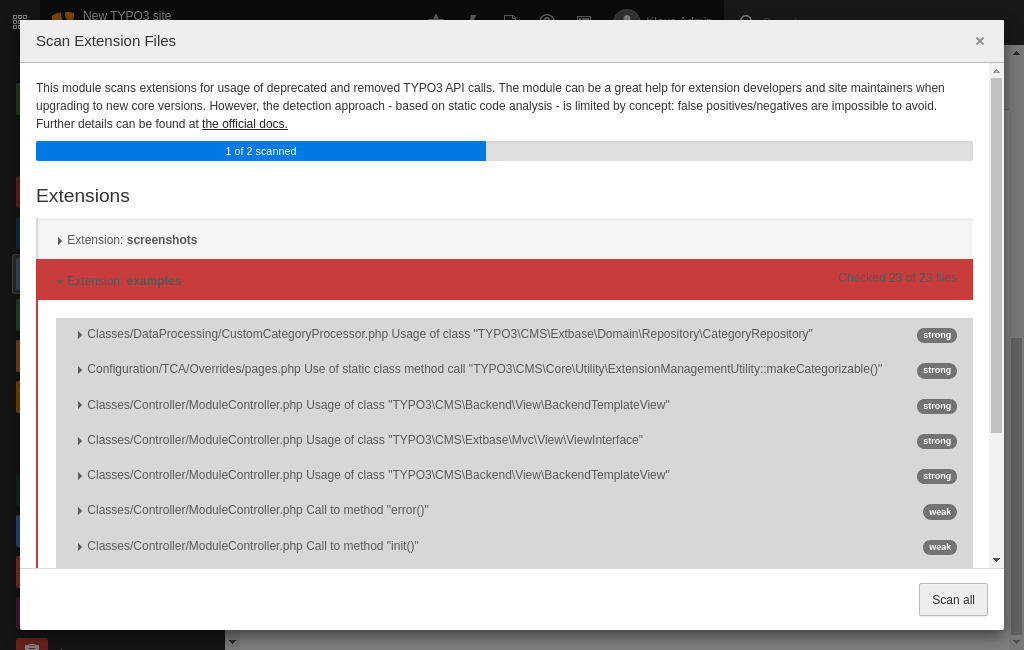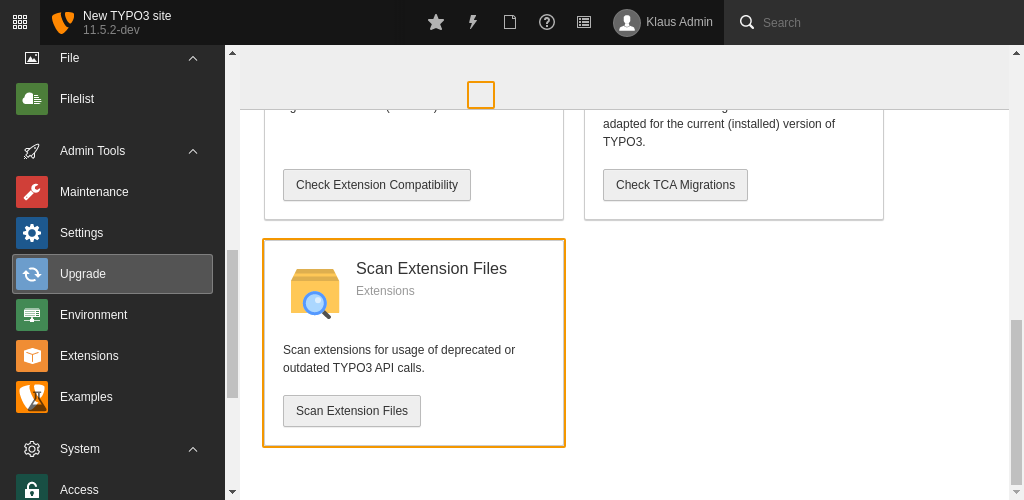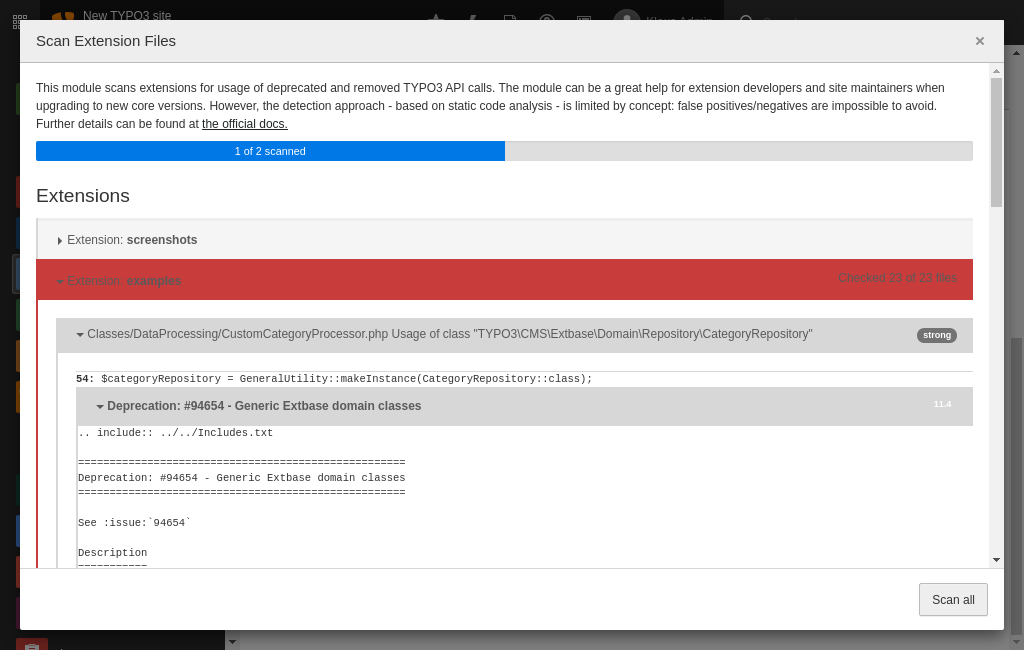Attention
TYPO3 v11 has reached end-of-life as of October 31th 2024 and is no longer being maintained. Use the version switcher on the top left of this page to select documentation for a supported version of TYPO3.
Need more time before upgrading? You can purchase Extended Long Term Support (ELTS) for TYPO3 v11 here: TYPO3 ELTS.
Extension scanner
Introduction
The extension scanner provides an interactive interface to scan extension code for usage of TYPO3 Core API which has been removed or deprecated.

The Extension Scanner
The module can be a great help for extension developers and site maintainers when upgrading to new Core versions. It can point out code places within extensions that need attention. However, the detection approach - based on static code analysis - is limited by concept: false positives/negatives are impossible to avoid.
This document has been written to explain the design goals of the scanner, to point out what it can and can't do. The document should help extension and project developers to get the best out of the tool, and it should help Core developers to add Core patches which use the scanner.
This module has been featured on the TYPO3 youtube channel:
Quick start
-
Open extension scanner from the TYPO3 backend:
Admin Tools > Upgrade > Scan Extension Files

Open the extension scanner from the Admin Tools
- Scan one extension by clicking on it or click "Scan all".
-
View the report:
The tags weak, strong, etc. will give you an idea of how well the extension scanner was able to match. Hover over the tags with the mouse to see a tooltip.
Click on the Changelog to view it.

View extension scanner report
Goals and non goals
- Help extension authors quickly find code in extensions that may need attention when upgrading to newer Core versions.
- Extend the existing reST documentation files which are shown in the
Upgrade Analysissection with additional information giving extension authors and site developers hints if they are affected by a specific change. - It is not a design goal to scan for every TYPO3 Core API change.
- It should later be possible to scan different languages - not only PHP - TypoScript or Fluid could be examples.
- Core developers should be able to easily register and maintain matchers for new deprecations or breaking patches.
- Implementation within the TYPO3 Core backend has been primary goal. While it might be possible, integration into IDEs like PhpStorm has not been a design goal. Also, matcher configuration is bound to the Core version, e.g. tests concerning v12 are not intended to be executed on v11.
- Some of reST files that document a breaking change or deprecated API can be used to scan extensions. If those find no matches, the reST documentation files are tagged with a "no match" label telling integrators and project developers that they do not need to concern themselves with that particular change.
- The extension scanner is not meant to be used on Core extensions - it is not a Core development helper.
Limits
The extension scanner is based on static code analysis. "Understanding and analyzing" code flow from within code itself (dynamic code analysis) is not performed. This means the scanner is basically not much more clever than a simple string search paired with some additional analysis to reduce false positives/negatives.
Let's explain this by example. Suppose a static method was deprecated:
<?php
namespace TYPO3\CMS\Core\Utility;
class SomeUtility
{
/**
* @deprecated since ...
*/
public static function someMethod($foo = '') {
// do something deprecated
}
}This method is registered in the matcher class
\TYPO3\ like this:
'TYPO3\CMS\Core\Utility\SomeUtility::someMethod' => [
'numberOfMandatoryArguments' => 0,
'maximumNumberOfArguments' => 1,
'restFiles' => [
'Deprecation-12345-DeprecateSomeMethod.rst',
],
],The array key is the class name plus method name,
number is the number
of arguments that must be passed to the method,
maximum is the maximum
number of arguments the method accepts. The
rest array contains file names of
.rst file(s) that explain details of the deprecation.
Now let's look at a theoretical class of an extension that uses this deprecated method:
<?php
namespace My\Extension\Consumer;
use TYPO3\CMS\Core\Utility\SomeUtility;
class SomeClass
{
public function someMethod()
{
// "Strong" match: Full class combination and method call matches
\TYPO3\CMS\Core\Utility\SomeUtility::someMethod();
// "Strong" match: Full class combination and method call matches
\TYPO3\CMS\Core\Utility\SomeUtility::someMethod('foo');
// "Strong" match: Use statements are resolved
SomeUtility::someMethod('foo');
// "Weak" match: Scanner does not know if $foo is class "SomeUtility", but method name matches
$foo = '\TYPO3\CMS\Core\Utility\SomeOtherUtility';
$foo::someMethod();
// No match: The method is static but called dynamically
$foo->someMethod();
// No match: The method is called with too many arguments
SomeUtility::someMethod('foo', 'bar');
// No match: A different method is called
SomeUtility::someOtherMethod();
}
}The first three method calls are classified as strong matches: the full class name is used
and the method name matches including the argument restrictions.
The fourth call
$foo:: is classified as a weak match and is a false
positive: Class
Some is called instead of
Some.
The sixth method call
Some does not match because the
method is called with two arguments instead of one argument.
The "too many arguments" restriction is a measure to suppress false positives: If a method with the same name exists which accepts a different number of arguments, valid calls to the other method may be reported as false positives depending on the number of arguments used in the call.
As you can see, depending on given extension code, the scanner may find false positives and it may not find matches if for instance the number of arguments is not within a specified range.
The example above looks for static method calls, which are relatively reliable to match. For dynamic
-> method call, a strong match on the class name is almost never achieved, which means almost
all matches for such cases will be weak matches.
Additionally, an extension may already have a version check around a function call to run one function on one Core version and a different one on another Core version. The extension scanner does not understand these constructs and would still show the deprecated call as a match, even if it was wrapped in a Core version check.
Extension authors
Even though the extension scanner can be a great help to quickly see which places of an extension may need attention when upgrading to a newer Core version, the following points should be considered:
- It should not be a goal to always have a green output of the extension scanner, especially if the extension scanner shows a false positive.
- A green output when scanning an extension does not imply that the extension actually works with that Core version: Some deprecations or breaking changes are not scanned (for example those causing too many false positives) and the scanner does not support all script/markup languages.
- The breaking change / deprecation reST files shipped with a Core version are still relevant and should be read.
-
If the extension scanner shows one or more false positives the extension author has the following options:
- Ignore the false positive
-
Suppress a single match with an inline comment:
// @extensionScannerIgnoreLine $foo->someFalsePositiveMatch('foo');Copied! -
Suppress all matches in an entire file with a comment. This is especially useful for dedicated classes which act as proxies for Core API:
<?php /** * @extensionScannerIgnoreFile */ class SomeClassIgnoredByExtensionScanner { ... }Copied! - The author could request a Core patch to remove a specific match from the extension scanner if it triggers too many false positives. If multiple authors experience the same false positives they are even more likely to be removed upon request.
- Some of the matchers can be restricted to only include strong matches and ignore weak ones. The extension author may request a "strong match only" patch for specific cases to suppress common false positives.
- If a PHP file is invalid and can not be compiled for a given PHP version, the extension scanner may throw a general parse error for that file. Additionally, if an extension calls a matched method with too many arguments (which is valid in PHP) then the extension scanner will not show that as a match. In general: the cleaner the code base of a given extension is and the simpler the code lines are, the more useful the extension scanner will be.
- If an extension is cluttered with
@extensionScannerIgnoreLineor@extensionScannerIgnoreFileannotations this could be an indication to the extension author to consider branching off an extensions to support individual Core versions instead of supporting multiple versions in the same release.
Project developers
Project developers are developers who maintain a project that consists of third party extensions (eg. from TER) together with some custom, project-specific extensions. When analysing the output of an extension scanner run the following points should be considered:
- It is not necessary for all scanned extensions to report green status. Due to the nature of the extension scanner which can show false positives, extension authors may decide to ignore a false positive (see above). That means that even well maintained extensions may not report green.
- A green status in the scanner does not imply that the extension also works, just that it neither uses deprecated methods nor any Core API which received breaking changes. It also does not indicate anything about the quality of the extension: false positives can be caused by for example supporting multiple TYPO3 versions in the same extension release.
Core developers
When you are working on the TYPO3 Core and deprecate or remove functionality you can find information in Core Contribution Guide, appendix Extension Scanner.
